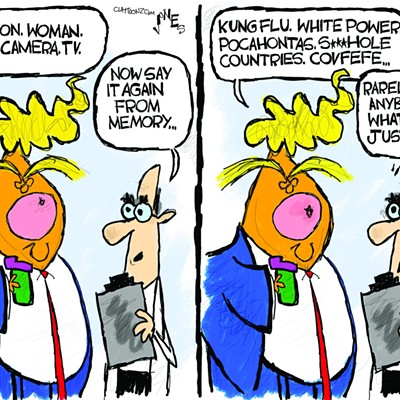The Great Hall at MOCA right now contains exactly what you'd expect to see in a venue for über-cool contemporary art.
Dangling from the ceiling of the industrial space—once the garage of the downtown firehouse—are minimalist sculptures so spare and so neutrally colored that you barely register their presence when you enter the room.
A delicate aluminum mobile by Armando Miguelez shimmers almost invisibly in the air. A glowing white-blue neon tube by Mathieu Mercier coils around an old fluorescent light on the ceiling. And a piece by the front door—a text painted on a wall, "I'll Try Harder Next Time," by Alex von Bergen—masquerades as museum signage.
These cool, cerebral works, part of a new show called Made in Tucson/Born in Tucson/Live in Tucson Part 2, are mostly about pure form, about art stripped down.
So it's a surprise to find, hidden away in the back galleries, art that is their opposite number. The little galleries, once the offices of the fire chief and his deputies, are filled with hot and impassioned pieces—vivid paintings, a fervent video and elaborate installations—that engage with real-world issues.
Paco Velez has poured out his rage about deaths along the border into a full-room installation brimming with battered and bloodied toy rabbits, each identified as Juan or Juana Doe ("Teratology w/Chalk, 1, 2, 3, 4"). The bunnies hang on the wall, pawless or armless, spattered with red paint. And each has a cause of death listed on a placard below. One Juanita, age 23, is said to have drowned in the sewer under Nogales in a monsoon, as two real-life migrants did in July 2008. This bunny is drenched in brown.
Velez's savage paintings, scrawled with angry texts in Spanish and English, take their aesthetic from the painted, lettered walls in Mexican towns. Rabbits occasionally dart through the saturated paintings. Border-born in Nogales, Sonora, and educated on this side of the line, Velez has long used the agile, canny rabbit as a metaphor for migrants crossing the dangerous frontera.
In the video room, Lucy Raven is running a shaky movie about the ravages wrought by mining. Her "Chinatown" looks at a vast open-pit mine in Nevada, but the lessons are well-taken here at home, where the Rosemont Mine could soon destroy not only the ecology, but the extraordinary beauty of the Santa Rita slopes. To take her up-close-and-personal look at the giant Nevada pit, the intrepid Raven rode with mineworkers in trucks, filming huge quantities of debris being dumped onto the land, and recording the cacophony created by the big mining machines. She also took long-view shots of the scarred valley, crisscrossed by roads and pockmarked by excavations.
In Northeast Gallery, two painters who've wielded their loaded brushes on giant canvases compete to define the meaning of painting itself.
An untitled work from 1980 by the late Dean Narcho conjures up the Earth. A Tohono O'odham painter who helped found Dinnerware, Narcho worked in the contemporary modes of pattern painting and color field, but he also drew on Native American design. He was more or less neglected before his early death in 2005, but his rep is deservedly picking up. One of his works is on view in the abstraction show that just opened at the Tucson Museum of Art; his acrylic at MOCA is 30 years old, but it looks fresh again.
The background is dense with small pink ovals against green; they're like cells wiggling in a primeval soup. On top of these amoebae, a tubular organic-edged rope, painted in the earth tones of gray, burnt sienna and ochre, writhes up and down the canvas. It's like roots diving deep into the desert, a snake slithering across its surface, a saguaro raising its arms on O'odham land.
Facing down Narcho's work is Matt Cotten's equally monumental "Yard Lore." Cotten's painting is narrative to Narcho's abstract, and it likewise re-creates the Earth, but as kids see it. Cotten paints the geography and psychology of childhood in deeply pigmented colors and simple shapes. A large-scale version of the paintings Cotten exhibited at the UA Poetry Center earlier this year, "Yard Lore" has a tribe of kids inhabiting a no-adults-land of unvarnished sensation and emotion.
The Narcho-Cotten duel ends in a draw; aesthetically, both have their merits, and both grasp at life's truths.
Two painters who teach at the UA deliver works limning Eastern Europe, particularly its packed cities. Russian native Dimitri Kozyrev paints interesting flat figures in strangely washed-out colors; his uneasy paintings suggest a coming conflagration. In "#3," Armageddon is already here. What seem to be buildings are tumbling to the sides, and an upside-down body—of a child?—is trapped in the middle.
Lawrence Gipe's "Warsaw 1962" pictures a Communist-era apartment block in a painting that stretches 8 feet across. The endless, and endlessly bland, rows of balconies and windows add up to an abstraction. But upon closer inspection, the relentless grid of gray and white dissolves into quirky brush strokes and patches of color striving to make themselves seen. The brave little lavenders and blues are tidy metaphors for individuals rebelling, if quietly, against conformity.
Cities also inspired two up-to-the-minute sculptors, each with a UA master's degree. Kim Largey's "I Did Not Know Him. I Wish I Had" is another full-room installation. Largey, who earned an MFA at the UA, constructed an entire city in one corner using raw wooden blocks, its buildings in ascending order: the smallest in front, the tallest in back. Pink strings on the floor lead to a smaller city. And flying yellow rowboats, tethered by strings to the ceiling, sail up in the air to a city on a shelf. The mournful title suggests this is about the sweep of someone's life, from the small place to the big city to that paradisiacal metropolis in the sky.
Chika Matsuda's paper-and-wood city is possibly the coolest piece in the show. In her "Static Motion," 16 white columns stand in a grid. Atop these hollow pillars, delicate squares of white paper float up and down, pushed aloft by air shot up by a hidden fan. Her city is inanimate and alive all at once.
This delightful work demands that you pay some attention to her more difficult "When the Universe Leaks," back in the minimalist Great Hall. This Matsuda work is by no means as pretty or as fun as her paper city. Black wire descends from a black disc near the ceiling, leading to a black spill of paint spreading across the floor. Made this year, the piece inescapably suggests the disaster in the Gulf of Mexico, caused in no small part by the demand for oil in those cities that the back-gallery artists lovingly delineate.
Nearby, Gwyneth Scally's "Jelly" is an ethereal school of dangling jellyfish crafted from fiberglass and fabric. Still another MFA grad of the UA, Scally has been doing works about global warming for a while; her lovely—but stinging—jellyfish are a reminder that skyrocketing sea temperatures have helped trigger infestations of jellyfish in the Chesapeake Bay and elsewhere. She made "Jelly" in 2009, but in this year of environmental catastrophe, it takes on new urgency.
In their quieter way, these Great Hall pieces also speak up for the Earth.














